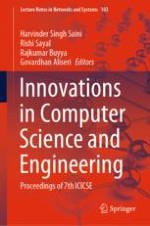2020 | Buch
Innovations in Computer Science and Engineering
Proceedings of 7th ICICSE
herausgegeben von: Dr. Harvinder Singh Saini, Dr. Rishi Sayal, Prof. Dr. Rajkumar Buyya, Dr. Govardhan Aliseri
Verlag: Springer Singapore
Buchreihe : Lecture Notes in Networks and Systems
